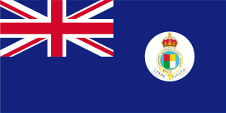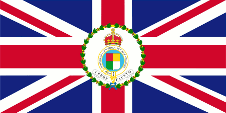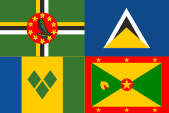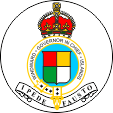zur deutschen Version, Flagge klicken oder tippen

- British Windward Islands Colony
- former federal possession of United Kingdom
- own name:
Federal Colony of the British Windward Islands
• Flags
• Meaning/Origin of the Flag
• Coat of Arms
• Meaning/Origin of the Coat of Arms
• Map
• Numbers and Facts
• History
• Origin of the Country's Name

1903–1958, doubtful,
Flag of the government (state flag),
ratio = 1:2,
Source, by: Flags of the World




1885–1960,
Flag of the Governor-in-Chief,
ratio = 1:2,
Source, by: Flags of the World




today's Flag of Windward Islands Cricket Team,
ratio = 2:3,
Source, by: Wikipedia (EN)




The Colony of the British Windward Islands was a federal colony consisting of individual sub-territories, sub-colonies or islands. These individual colonies had their own flags, also called "Blue Ensigns" with their own badge, for use by the governments of these colonies. The overarching political entity of the British Windward Islands most likely did not have an additional Blue Ensign of its own. The Governor of Barbados was always also the Governor-in-Chief of the colony of the British Windward Islands. The Governor-in-Chief used the Windward Islands badge on his flag after all. He was represented locally by a governor in the associated sub-territory, sub-colony or island. The federal colony ceased to exist when it was incorporated into the Federation of the West Indies, led by a Governor-General. Locally, in the associated sub-territory, sub-colony or island, the highest representative of the Crown retained his rank. He remained an administrator or governor. The local flags (e.g. blue or red ensigns, i.e. separate state or merchant flags) have been retained. The Colony of the British Windward Islands was founded in 1834, combining the possessions of Barbados, Grenada, St Vincent and Tobago. St Lucia was added in 1838, Barbados was separated in 1885 and Tobago in 1889. Dominica was added in 1939. In 1958, the country joined the West Indies Federation.
From the time, the individual islands became British possessions, individuals, citizens and also the authorities represented their status as citizens or organs of the British nation, embodied in the United Kingdom, through the use of the Union Jack, also called the "Union Flag". At sea, the British merchant flag, the Red Ensign, was intended for British citizens from 1864. In a few cases, the citizens of a colony were authorised by the British Admiralty to use their own Red Ensign with the colony's badge at sea. The Union Jack in the top corner of these flags signalled the connections to United Kingdom.
United Kingdom introduced a flag system in 1864 in which:
• war ships fly the "White Ensign" (naval flag), a white flag often with an uninterrupted red St. George's-Cross and with the Union Jack in the upper staff quadrant of the flag,
• merchant ships fly a "Red Ensign" (also named "Civil Ensign" → civil flag, the real merchant flag), a red flag with the Union Jack in the upper staff quadrant of the flag, and
• governmental ships fly the "Blue Ensign" (flag for the use by the gouvernment → the actual state flag), a blue flag with the Union Jack in the upper staff quadrant of the flag.
From 1865, the ships of the colonial governments were allowed to use a Blue Ensign with a badge at the flying end. The respective governments were to provide appropriate badges. Merchant ships and seafaring privateers from colonies were only allowed to use a Red Ensign with a badge if the British Admiralty had issued a corresponding licence for that colony. Such a badge was often a regional landscape depiction on a disc, often showed ships, historical events or could simply be a kind of logo. Very often a badge also contained the name of the country or a motto. However, some possessions had a coat of arms from the beginning or were given their own coat of arms over the years and the badge was abolished. To ensure a largely uniform appearance in the flying end of the flags, coats of arms and other symbols were displayed on a white disc in the size of the former badges. However, there were also exceptions, as some colonies dispensed with this white disc and placed their coat of arms or even just the shield – sometimes enlarged – directly on the bunting. As early as the 1940s, the white disc was removed and the coat of arms was applied directly or enlarged. This conversion process took place gradually, nowhere simultaneously and completely. In some British possessions flags with the white disc are still in use today, in others no longer and in some areas both variants exist side by side.
The British Windward Islands were given their own badge in 1885. It showed a heraldic shield divided into four parts with the colours red, yellow, green and white, surrounded by a white belt with the inscription "Governor in Chief, Windward Islands ", with the British crown above. Below is a white banner with the motto of the islands: "i pede fausto" → "Walk with a blessed foot". In 1903, the design of the crown was changed slightly (to the Tudor crown).
To this day, the Windward Islands have their own joint cricket team, which includes the following territories: Dominica, Grenada, Saint Lucia and Saint Vincent and the Grenadines. The flags of these countries are united on the flag of the Windward Islands Cricket Team.
Source:
Die Welt der Flaggen,
Wikipedia (EN),
Flags of the World,
Flaggenbuch 1939


Badge,
Source, by:
Flags of the World

The Windward Islands became awarded an own badge in the year 1886. It showed a fourfold divided shield with the colours red, yellow, green and white, surrounded by a white belt with the inscription "Governor in Chief, Windward Islands", above the British crown. Below a white banner with the motto of the islands: "i pede fausto" → "go with blessed foot". In 1903 the design of the crown was changed a little bit (to the Tudor crown).
Source:
Wikipedia (EN),
Flags of the World

Interactive Map of the Windward Islands:

Source: Freeware, University of Texas Libraries,
modyfied by: Volker Preuß

Area: 810 square miles (1960), thereof (between 1939 and 1958) the today's states: Grenada, St. Vincent, St. Lucia, Dominica
Inhabitants: ca. 261.100 (1938)
Capital: Saint George's (on Grenada), 8.000 inh. (1960)
official Language: English
Currency: East Caribbean Dollar (EC-$) = 100 Cent
Time Zone: GMT – 4 h
Source:
Wikipedia (EN),
World Statesmen

1834 · establishment of the colony of the British Windward Islands (by unification of the possessions of Barbados, Grenada, St. Vincent and Tobago)
1838 · St. Lucia becomes affiliated to the colony
1871 · introduction of federal structures with limited self administration for the separate islands "Federal Colony of the Windward Islands"
1885 · Barbados becomes excorporated out of the colony
1889 · Tobago becomes excorporated out of the colony
1939 · Dominica becomes excorporated out of the colony of the Leeward Islands and affiliated to the colony of the British Windward Islands
1956 · rename in "Territory of the Windward Islands“
1958 · the Windward Islands become a part of the Federation of the West Indies
1st of January 1960 · dissolution of the colony in several self-contained colonies: 1.) Grenada, 2.) St. Vincent, 3.) St. Lucia, 4.) Dominica
Source:
Wikipedia (EN),
World Statesmen

The name "Windward Islands" means "the windward placed islands" (on the from the direction of the wind turned towards side). In this way the in the sorthern Lesser Antillas placed islands are called until today. The name has its roots in the trade winds of this geographical latitudes. In German they are called "Inseln über dem Wind" (Islands below the Wind).
Source:
Volker Preuß


![]()











